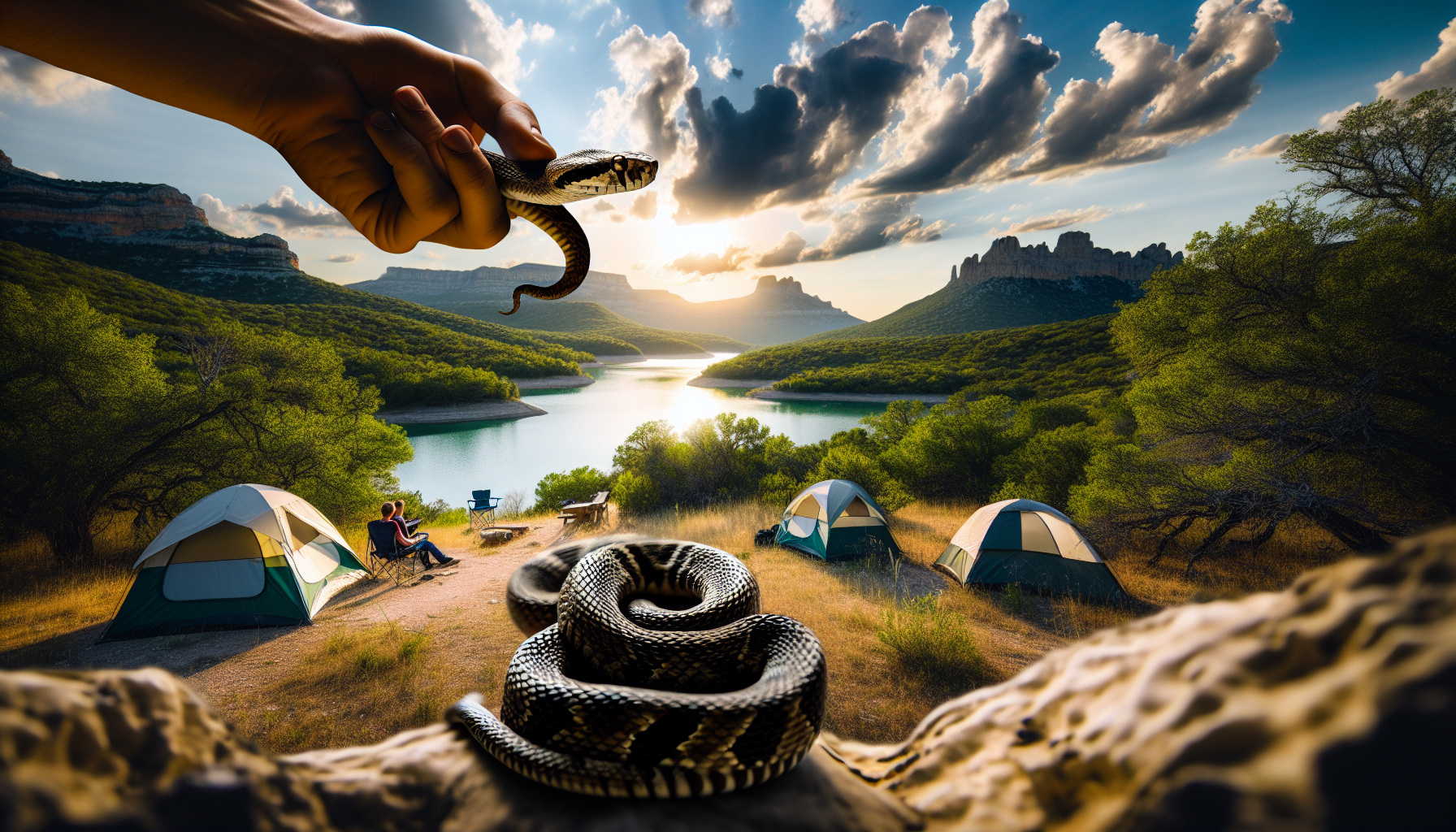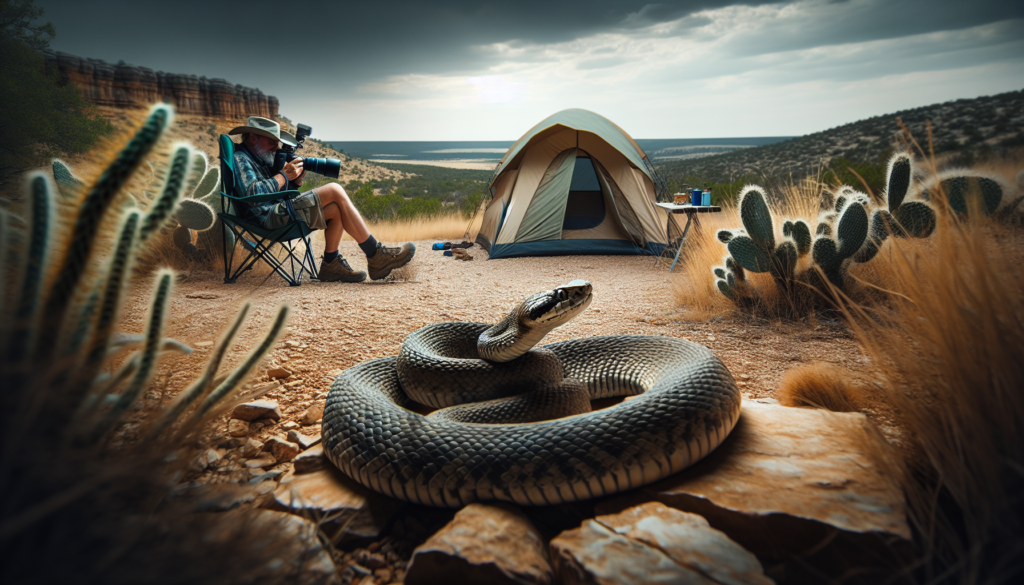
When it comes to camping in the vast wilderness of Texas, encountering snakes is a possibility that we should be prepared for. While these slithery creatures may cause some initial concern, it’s essential to remain calm and handle the situation with caution. In this article, we will share some practical tips on how to manage an encounter with a snake during your outdoor adventure in the Lone Star State. So, if you ever find yourself face-to-face with one of nature’s most fascinating creatures, fear not – we’ve got you covered!
Identify the snake
When encountering a snake while camping in Texas, the first step is to identify the snake. This will help in determining if the snake is venomous or not. Look for physical characteristics such as the color and pattern on its scales, the shape of its head, and the size of its body. Take note of any distinctive markings or features.
Additionally, observe the snake’s behavior. Is it slithering away from you or coiling up defensively? Understanding its behavior can provide valuable information about its intentions and whether it poses a threat. Take your time to carefully assess the snake from a safe distance before proceeding.
Maintain a safe distance
The next crucial step is to maintain a safe distance from the snake. Remember, snakes generally prefer to avoid confrontation with humans. To ensure your safety, it is important not to approach the snake or make any sudden movements that could startle or provoke it.
Stay at least 5 feet away from the snake to minimize the risk of being bitten. This distance will give you a buffer zone in case the snake decides to strike. By maintaining a safe distance, you can observe and assess the situation without putting yourself or others in harm’s way.

Do not panic
Encountering a snake can be an unnerving experience, but it is important to remain calm. Panicking or making sudden movements can startle the snake, increasing the likelihood of aggression or an defensive response. Take deep breaths and try to remain as calm as possible.
Avoid making any abrupt or erratic movements that might be interpreted as a threat by the snake. Keeping a cool head will help you make rational decisions and take appropriate actions to ensure everyone’s safety.
Alert others
Once you have identified and safely distanced yourself from the snake, it is important to notify your camping companions and warn nearby campers. By alerting others, you can prevent them from accidentally stumbling upon the snake and potentially causing harm to themselves or the snake.
Inform your camping companions about the presence of the snake and advise them to keep their distance. Additionally, if there are other campers around, make an effort to warn them about the snake’s presence. This proactive approach can help create a safer camping environment for everyone involved.

Do not provoke or handle the snake
Under no circumstances should you attempt to touch or pick up the snake. Snakes are wild animals and should be respected as such. Trying to handle or provoke a snake can result in a defensive or aggressive response, putting yourself at risk of being bitten.
Avoid throwing objects at the snake or engaging in any behavior that may provoke it. Remember, snakes generally prefer to avoid confrontation, and it is our responsibility to respect their space and natural behavior.
Back away slowly
If you find yourself in close proximity to the snake, it is important to calmly and slowly back away. Moving away hastily or erratically might startle the snake and trigger a defensive response.
As you back away, maintain eye contact with the snake. This can help you gauge its reaction and ensure it does not feel threatened by any sudden movements you may make. By giving the snake a clear path to retreat, you are reducing the chances of a potential conflict.
Leave the snake alone
Once you have safely distanced yourself from the snake, it is crucial to leave it alone and allow it to move away. Continued observation from a safe distance is acceptable, but avoid following or chasing the snake.
Remember, snakes are an important part of the ecosystem and play a vital role in maintaining balance. By giving them space and allowing them to go about their natural behavior, we are contributing to the preservation of these creatures and their habitats.
Secure your camping area
To minimize the likelihood of encountering snakes while camping, it is important to take measures to secure your camping area. Clearing debris and clutter from the campsite helps eliminate potential hiding spots for snakes.
Additionally, proper food storage is crucial to discourage snake attraction. Seal all food properly in airtight containers to minimize odors that may attract snakes or other wildlife. By maintaining a clean and organized campsite, you can greatly reduce the chances of encountering snakes.
Seek medical attention if bitten
In the unfortunate event of a snake bite, it is imperative to seek medical attention immediately. Time is of the essence when dealing with snake bites, so it is crucial to act swiftly.
If possible, try to identify the species of the snake that bit you. This information will assist medical professionals in providing the appropriate treatment and antidote if necessary. Stay as calm as possible and follow emergency protocols for snake bites while awaiting medical assistance.
Educate yourself about snakes
To better prepare for encounters with snakes while camping in Texas, it is important to educate ourselves about snakes in general. Texas is home to various species of venomous snakes, including the Western Diamondback Rattlesnake, Copperhead Snake, and Cottonmouth Snake.
By familiarizing ourselves with the characteristics, behavior, and habitats of these venomous snakes, we can better understand how to avoid them and respond appropriately when encountering them. It is also important to learn about non-venomous snakes in Texas as they too play a vital role in the ecosystem.
In conclusion, encountering a snake while camping in Texas can be a nerve-wracking experience, but by following a few key steps, we can ensure our safety and the well-being of the snake. Remember to identify the snake, maintain a safe distance, stay calm, and alert others. Avoid provoking or handling the snake and calmly back away while maintaining eye contact. Leave the snake alone and secure your camping area to minimize the chance of further encounters. Seek immediate medical attention if bitten and educate yourself about snakes in Texas to be better prepared in the future. By taking these precautions and respecting snakes as essential elements of our natural environment, we can coexist peacefully with them while enjoying our camping adventures.